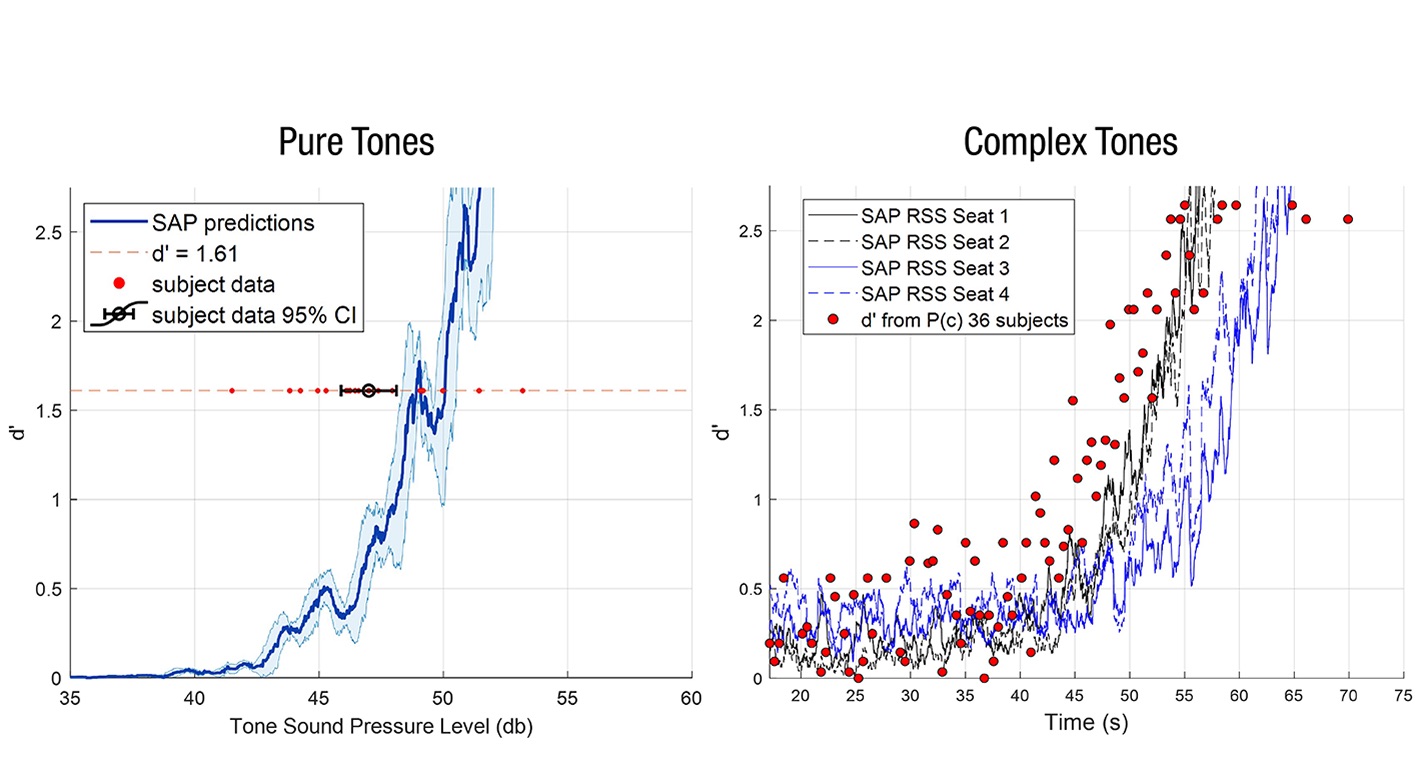Statistical Audibility Prediction (SAP) Algorithm
Information Technology and Software
Statistical Audibility Prediction (SAP) Algorithm (LAR-TOPS-360)
Determining the audibility of sound
Overview
Noise is difficult to escape in our daily lives. Such noise is generated by transportation vehicles, industrial equipment, hospital machines, phones, alarms, crowds, and more. Some sounds we want to suppress (e.g., airplane noise vs. conversation) and others we want to enhance (e.g., our ringing phone vs. subway noise). Predicting the extent that one sound is heard over another is difficult, yet could help engineers to better design for sound management.
Innovators at the NASA Langley Research Center (LaRC) and the National Institute of Aerospace (NIA) have developed an algorithm for Statistical Audibility Prediction (SAP) of an arbitrary signal in the presence of noise. The SAP algorithm compares the loudness of signal and noise samples at matching time instances to assess audibility versus time. The continued development of this algorithm could allow engineers to suppress how we hear noise relative to sounds of interest. SAP can be implemented either as software or hardware. The algorithm has been tested using subject response data gathered in the Exterior Effects Room (EER) at NASA LaRC.
The Technology
A method for predicting the audibility of an arbitrary time-varying noise (signal) in the presence of masking noise is described in "An Algorithm for Statistical Audibility Prediction (SAP) of an Arbitrary Signal in the Presence of Noise" published in the Journal of the Audio Engineering Society (Vo. 69, No. 9, September 2021). The SAP method relies on the specific loudness, or loudness perceived through the individual auditory filters, for accurate statistical estimation of audibility vs. time. As such, this work investigated a new hypothesis that audibility is more accurately discerned within individual auditory filters by a higher-level, decision-making process. Audibility prediction vs. time is intuitive since it captures changes in audibility with time as it occurs, critical for the study of human response to noise. Concurrently, time-frequency prediction of audibility may provide valuable information about the root cause(s) for audibility useful for the design and operation of sources of noise. Empirical data, gathered under a three-alternative forced-choice (3AFC) test paradigm for low-frequency sound, has been used to examine the accuracy of SAPs.
Future work should involve additional studies to examine the performance of SAP with realistic ambient noise and signals with higher-frequency content.


Benefits
- Less noise pollution: Can help engineers design systems that generate noise that is less bothersome.
- Better sound selectivity: Can lead to systems that generate sounds more likely to be heard over background noise.
- Enhanced understanding of audibility: Can assist scientists and engineers to better understand why certain sounds are more or less audible than others, thus further enhancing sound design.
Applications
- Noise management
- Sound engineering
- Transportation vehicles (e.g., aircraft, rotorcraft, drones, unmanned aerial vehicles, trucks, automobiles, trains, buses, etc.)
- Industrial equipment (e.g., as found in factories, hospitals, businesses, residences, etc.)
- Communication decives (e.g., phones, alarms, etc.)
- Hearing aids
- Signal processing
Technology Details
Information Technology and Software
LAR-TOPS-360
LAR-19736-1
M. Rafaelof, and K. Wendling, "An Algorithm for Statistical Audibility Prediction (SAP) of an Arbitrary Signal in the Presence of Noise," J. Audio Eng. Soc., vol. 69, no. 9, pp. 672-682, (2021 September.)
|
Related Links:
|
Similar Results

Application of Leading Edge Serration and Trailing Edge Foam for Undercarriage Wheel Cavity Noise Reduction
Among the tests, landing gear cavities, a known cause of airframe noise, were evaluated. These are the regions where the landing gear deploys from the main body of an aircraft, typically leaving a large cavity where airflow can get pulled in, creating noise. NASA applied two concepts to these sections, including a series of chevrons placed near the front of the cavity with a sound-absorbing foam at the trailing wall, as well as a net that stretched across the opening of the main landing gear cavity. This altered the airflow and reduced the noise resulting from the interactions between the air, the cavity walls, and its edges.

A Method for Reducing Broadband Noise
This NASA technology is ideally suited to absorb sounds below 1000 Hz (at the low end of human auditory range), which commercially available materials have struggled to absorb effectively. NASA innovators designed the acoustic liner to mimic the geometry and the low-frequency acoustic absorption of natural reeds. To provide excellent noise absorption that endures even in a variety of challenging conditions, researchers have created and tested prototypes of acoustic filters using thin and lightweight parallel-stacked tubes one-fourth to three-eights of an inch in diameter. The assembly can feature a porous or perforated face sheet positioned on one or more sides of the acoustic absorber layer to increase noise-reduction capability as needed. These filters have demonstrated exceptional acoustic absorption coefficients in the frequency range of 400 to 3000 Hz. Results indicate that these assemblies can be additively manufactured from synthetic materials, generally plastic; however, ceramics, metals, or other materials can also be used. The reeds can be narrow or wide, hollow or solid, straight or bent, etc., giving this acoustic liner remarkable flexibility and versatility to meet the needs of virtually any application. This technology effectively demonstrates that a new class of structures can now be considered for a wide range of environments and applications that need durable, lightweight, broadband acoustic absorption that is effective at various frequencies, particularly between 400 and 3000 Hz.

Low, Drag, Variable-Depth Acoustic Liner
The drag penalty incurred by a conventional acoustic liner is dependent, to a large extent, on the perforate open area ratio (porosity) of the perforated facesheet. As the open area ratio is decreased, the facesheet behaves more like a solid surface and the drag is reduced. However, if the open area ratio is too small, the external acoustic field will be isolated from the resonators (in the liner), and the system will not provide noise reduction.
The technology is a new type of variable-depth acoustic engine liner, which will reduce the drag and potentially manufacturing cost of this class of engine liner. Individual resonators within a conventional variable-depth liner are effective near resonance, but provide less acoustic benefit at other frequencies. In fact, at anti-resonance, a resonator behaves similar to a hard wall (i.e., the normal component of the particle velocity at the inlet is zero). Therefore, the proposed innovation couples neighboring resonators (tuned for different frequencies) together within the core of the liner. In other words, multiple resonators share a single inlet/port. Sharing inlets reduces the overall number of openings needed to maintain the acoustic performance of the liner by a factor of two or more. Reducing the open area ratio will in turn reduce the liner drag, and will reduce the number of holes that have to be machined into the facesheet, potentially reducing manufacturing cost.
The functional operation of the proposed innovation will be identical to conventional engine liners. The innovation enables a reduction of the open area ratio of the perforated facesheet (by a factor of two or more) without degrading the acoustic performance. This will decrease the liner drag, and has the potential to reduce the manufacturing cost of the liner, since fewer holes need to be machined in the facesheet.

Interactive Sonic Boom Display
A supersonic shock wave forms a cone of pressurized air molecules that propagates outward in all directions and extends to the ground. Factors that influence sonic booms include aircraft weight, size, and shape, in addition to its altitude, speed, acceleration and flight path, and weather or atmospheric conditions. NASA's Real-Time Sonic Boom Display takes all these factors into account and enables pilots to control and mitigate sonic boom impacts.
How It Works
Armstrong's technology incorporates 3-dimensional (3D) Earth modeling and inputs of 3D atmospheric data. Central to the innovation is a processor that calculates significant information related to the potential for sonic booms based on an aircraft's specific operation. The processor calculates the sonic boom near a field source based on aircraft flight parameters, then ray traces the sonic boom to a ground location taking into account the near field source, environmental condition data, terrain data, and aircraft information. The processor signature ages the ray trace information to obtain a ground boom footprint and also calculates the ray trace information to obtain Mach cutoff condition altitudes and airspeeds.
Prediction data are integrated with a real-time, local-area moving-map display that is capable of displaying the aircraft's currently generated sonic boom footprint at all times. A pilot can choose from a menu of pre-programmed maneuvers such as accelerations, turns, or pushovers and the predicted sonic boom footprint for that maneuver appears on the map display. This allows pilots to select or modify a flight path or parameters to either avoid generating a sonic boom or to place the sonic boom in a specific location. The system also provides pilots with guidance on how to execute a chosen maneuver.
Why It Is Better
No other system exists to manage sonic booms in-flight. NASA's approach is unique in its ability to display in real time the location and intensity of shock waves caused by supersonic aircraft. The system allows pilots to make in-flight adjustments to control the intensity and location of sonic booms via an interactive display that can be integrated into cockpits or flight control rooms. The technology has been in use in Armstrong control rooms and simulators since 2000 and has aided several sonic boom research projects.
Aerospace companies have the technological capability to build faster aircraft for overland travel; however, the industry has not yet developed a system to support flight planning and management of sonic booms. The Real-Time Sonic Boom Display fills this need. The capabilities of this cutting-edge technology will help pave the way toward overland supersonic flight, as it is the key to ensuring that speed increases can be accomplished without disturbing population centers.

Multirotor Aircraft Noise Reduction
Noise produced by multirotor vehicles may be objectionable to some, especially as industry moves toward drone deliveries and potentially air taxi operations.
However, noise reductions can now be attained by synchronizing the rotation rate and then controlling the phase offset between neighboring rotors. The optimal phase offset is uniquely defined based on the number of blades and the relative location of each rotor and does not depend on the rotation rate, blade geometry, or other aspects of the vehicle design.
This technology is not viable for all multirotor aircraft but is applicable if the rotation rate of neighboring rotors can be synchronized mechanically or electronically.



